This article includes a list of general references, but it lacks sufficient corresponding inline citations .(July 2010) |
Boondocks Road (formerly Jap Road) is a 4.3-mile (6.9-kilometer) road in Fannett, Texas.
This article includes a list of general references, but it lacks sufficient corresponding inline citations .(July 2010) |
Boondocks Road (formerly Jap Road) is a 4.3-mile (6.9-kilometer) road in Fannett, Texas.
In the early 20th century, Japanese immigrant Yoshio Mayumi and his brother Yasuo settled in Fannett, purchasing 1734 acres (7 km2) of land. The two brought with them techniques for rice farming, which became the dominant agricultural activity of Jefferson County.
According to local tradition, in 1905 area residents collaborated to build a road to the Mayumi farm, and named the road "Jap Road" in their honor.
In 1924, Mayumi returned to Japan. Low rice prices and smaller harvests due to mismanaged land had rendered his farm unprofitable. The Immigration Act of 1924 and related anti-immigrant sentiment are also considered contributing factors to Mayumi's decision to leave the country.
Although Jap Road was named to honor its Japanese residents, by the end of the 20th century its name had taken on a new meaning. During World War II, "Jap" went from being an abbreviation for "Japanese" to an ethnic slur.
In 1993, advocacy groups, led by Beaumont teacher Sandra Nakata, [1] began pressuring the Jefferson County commissioners to change the name. The county commissioners responded by stating that "Jap Road" was not an ethnic slur and honored the road's original Japanese residents. They did, however, give the road's residents the chance to change the name if they so chose. Area residents, including descendants of the Japanese settlers, were highly resistant to any name change. Further efforts in 1999 also met with no success.
In 2004, the Japanese American Citizens League and the Anti-Defamation League filed complaints with the US Department of Transportation and the Department of Housing and Urban Development. Finally bowing to outside pressure, the Jefferson County commissioners ordered Jap Road's residents to select a new name by July 29, 2004. They chose opposition leaders Wayne Wright and Earl Callahan to oversee the selection.
The options presented to the road's residents included "Mayumi Road', "Japanese Road", "Japan Road", and "Boondocks Road". Out of 170 voting residents, over 100 chose "Boondocks Road". The Boondocks was a popular catfish restaurant that had closed a decade earlier. Anger at outside groups characterizing them as racists is the common explanation for residents' decision to entirely avoid using any of the Japanese-related names.

Orange County is a county located in the very southeastern corner of the U.S. state of Texas, sharing a boundary with Louisiana, within the Golden Triangle of Texas. As of the 2020 census, its population was 84,808. The county seat is the city of Orange, and it falls within the Beaumont–Port Arthur metropolitan area.
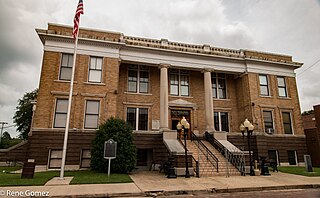
Marion County is a county located in the U.S. state of Texas. As of the 2020 census, its population was 9,725. Its county seat is Jefferson. Marion County is in East Texas and is named for Francis Marion, the Revolutionary War general from South Carolina who was nicknamed the "Swamp Fox".

Kleberg County is a county in the U.S. state of Texas. As of the 2020 census, its population was 31,040. The county seat is Kingsville. The county was organized in 1913 and is named for Robert J. Kleberg, an early settler.
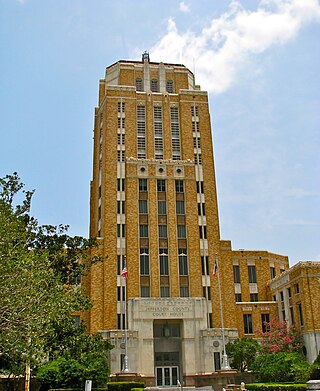
Jefferson County is a county in the Coastal Plain or Gulf Prairie region of Southeast Texas. The Neches River forms its northeastern boundary. As of the 2020 census, the population was 256,526. The county seat is Beaumont. Jefferson County has the highest percentage of African Americans in the state of Texas.

Guadalupe County is a county located in the U.S. state of Texas. As of the 2020 census, its population was 172,706. The county seat is Seguin. The county was founded in 1846 and is named after Guadalupe River.
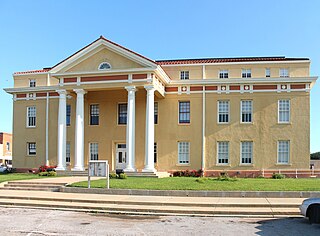
Cass County is a county located in the U.S. state of Texas. As of the 2020 census, its population was 28,454. The county seat is Linden. The county was named for United States Senator Lewis Cass (D-Michigan), who favored the U.S. annexation of Texas in the mid-19th century.
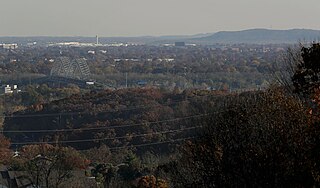
Floyd County is a county located in the U.S. state of Indiana. Its county seat is New Albany. The population of the county was 80,484 as of the 2020 United States Census. Floyd County has the second-smallest land area in the entire state. It was formed in the year 1819 from neighboring Clark and Harrison counties.

La Marque is a city in Galveston County, Texas, United States, south of Houston. The city population in 2020 was 18,030. La Marque experienced considerable growth in the 1950s, during which the city provided a general administrative and trades and crafts workforce helping to support the petrochemical complex in adjoining Texas City. It is the hometown of U.S. Senator Kay Bailey Hutchison and Norman Bulaich.

New Braunfels is a city in Comal and Guadalupe counties in the U.S. state of Texas. It is the seat of Comal County. The city covers 44.9 square miles (116 km2) and had a population of 90,403 as of the 2020 Census. A suburb just north of San Antonio, and part of the Greater San Antonio metropolitan area, it was the third-fastest-growing city in the United States from 2010 to 2020. As of 2022, the U.S. Census Bureau estimates its population at 104,707.
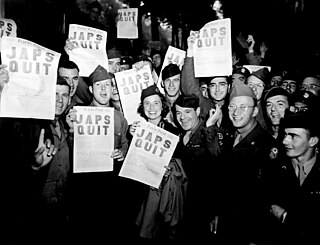
Jap is an English abbreviation of the word "Japanese". In some places, it is simply a contraction of the word and does not carry negative connotations, whereas in some other contexts it can be considered a slur.
Fannett is an unincorporated community and census-designated place (CDP) in Jefferson County, Texas, United States. The population was 2,363 at the 2020 census. It is about 15 miles (24 km) southwest of Beaumont and is part of the Beaumont–Port Arthur metropolitan area.
Jap is an English slur abbreviation of the word "Japanese".

The "Old Three Hundred" were 297 grantees who purchased 307 parcels of land from Stephen Fuller Austin in Mexican Texas. Each grantee was head of a household, or, in some cases, a partnership of unmarried men. Austin was an American approved in 1822 by Mexico as an empresario for this effort, after the nation had gained independence from Spain. By 1825 the colony had a population of 1,790, including 443 enslaved African Americans. Because the Americans believed they needed enslaved workers, Austin negotiated with the Mexican government to gain approval, as the new nation was opposed to slavery. Mexico abolished it in 1837.
Hamshire is an unincorporated community and census designated place (CDP) in western Jefferson County, Texas, United States. It is part of the Beaumont–Port Arthur Metropolitan Statistical Area and located on State Highway 124 twenty miles southwest of Beaumont. It was probably named for Lovan Hamshire, who developed the land as early as the 1870s. Hamshire was on the Gulf and Interstate Railway with a post office being established there in 1897. A townsite plat was filed in 1911 by Theodore F. Koch. Another major land dealer, Herbert Roedenbeck, subdivided additional land south of the railroad later that year, giving the subdivision the name Hamshire Gardens. Although there was interest shown by local rice farmers, Hamshire had only fifty inhabitants in 1928. The Fannett (1927) and Stowell (1941) oil fields discovery initiated new development in western Jefferson County. By 1940, the population in Hamshire had grown to 200. Natural gas production at the Hamshire field also continued to be of major importance to the community's economy through the 1980s. By 1985 the community had an estimated 350 residents and twenty-two businesses. In 1990 the population remained an estimated 350.
La Belle, also known as LaBelle, is an unincorporated community on Taylor Bayou and FM 365, approximately twelve miles south of Beaumont, in central Jefferson County, Texas, United States. It is part of the Beaumont–Port Arthur Metropolitan Statistical Area.
Kichimatsu Kishi was a Japanese immigrant to the United States who worked as a farmer and businessman. Along with fellow immigrants from Japan, his impact on rice farming in the southern United States would change the agricultural industry of the region. Kishi would establish an agricultural colony in Southeast Texas and would own an oil company. Born as one of eight children to a Japanese banker, he attended Hitotsubashi University in Tokyo, Japan, but was taken from his studies in 1904 to fight in the Russo-Japanese War.

In the U.S. state of Texas, Houston is the largest city by both population and area. With a 1850 United States census population of 2,396—and 596,163 a century later, in 1950—Houston's population has experienced positive growth trends. In 2000, the city had a population of 1,953,631 people in 717,945 households and 457,330 families, increasing to 2,304,580 at the 2020 census.

Taylor Landing is a city in Jefferson County, Texas, United States. It had a population of 278 at the 2020 census.
This article discusses Japanese Americans and Japanese citizens in Houston and Greater Houston.
Cheek is an unincorporated community, southwest of Beaumont in central Jefferson County, Texas, United States. In 1906, it was established by John R. Cheek. Although an identifiable community remains with a population of 550, the area is included within Beaumont city's jurisdiction.